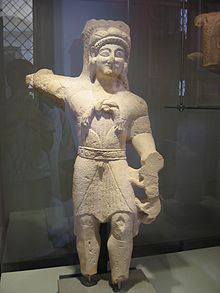Melkart

Melkart or Melqart , actually Milk-Qart ("city king", Baal of Tire ), was the main god of the Phoenician city of Tire. He is often referred to in inscriptions as Ba'l Ṣūr (Lord of Tire). He was also venerated in their daughter city, Carthage . He is considered the patron god of shipping and colonization, to whom the taming of the wild tribes on distant coasts, the founding of the Phoenician daughter cities, the introduction of order and law among the people is ascribed. He is depicted on a coin as he rides a sea horse . Later he was also considered the sun god , in whom the benevolent and the pernicious power of heaven (Ba'al and Moloch ) appear united, who overcomes the hostile signs of the zodiac and repeatedly leads the stars back from the summer heat and winter cold to beneficial effects. An eternal fire burned on his altar. In Interpretatio Graeca he is equated with Heracles and is often referred to as " Tyrian Heracles ".
Heracles Melkart
The Greeks identified him with Heracles as early as the time of Herodotus . Herodotus calls the temple of the Tyrian city god the Temple of Heracles and reports that there are two columns in the temple, one made of gold, the other made of emerald and so large that it shines in the dark. Lucian, however, expressly differentiates the Greek Heracles from the Tyrian Heracles, who is much older.
Strabo later describes the westernmost temple of the Tyrian Heracles, near the east coast of the island of Gades / Gadeira (modern Cádiz ). Strabo writes that the two bronze pillars, each eight cubits high, in the temple, widely proclaimed to many who visited the place, that they were the true pillars of Heracles and that they had to make offerings to Heracles there.
In the late antique epic Dionysiaka of the Nonnos of Panopolis , Dionysus visits Tire and the temple of the god, who appears here as Herakles Astrochiton ("Heracles with the starry dress") on his way home from the war against the Indians . Dionysus praises the god in a hymn speech. This tells him the founding legend of Tire.
According to this legend, Tire was founded on rocks that had previously wandered through the sea and only came to rest when the blood of an eagle was shed on them. This eagle nested in the branches of an olive tree , which was surrounded by a snake and stood in perpetual fire rising from a bowl without the tree, eagle and snake being consumed by the fire. On coins from Elagabal's time an olive tree appears between two beehive-shaped stones. It is unclear whether the two stones stand for the two legendary rocks on which Tire was founded, or whether they are cult stones known from the Semitic sanctuaries ( Bätylen ), corresponding to the columns that Herodotus reports. The rocks or stones were called ambrosial rocks ( ἀμβρόσιε πέτρε ). This can be understood as cult stones that have been anointed with butter, oil or honey.
In Greek mythology, Heracles Melkart was not only considered the founder of Tire, but also the discoverer of dyeing with purple . Heracles is said to have once stalked a nymph named Tire. When the dog of Heracles bit into a purple snail sitting on a cliff by the sea and its lips turned a beautiful red, the nymph declared that she would not receive Heracles again until he had procured her a dress of this color.
Due to the similarity of the name, an identifiability with the Greek Melikertes has been suggested, but the name similarity seems to be coincidental.
Sanctuaries
A famous sanctuary of Melkart existed in Cadiz , a foundation of the Phoenicians, (on the Isla de Sancti Petri ), which Hannibal is said to have visited before his famous journey across the Alps . The Almoravid governor destroyed it in 1146 in search of a legendary treasure. There was also a Melkart sanctuary in Kition on Cyprus.
literature
- Wolfgang Fauth : The hymn to Herakles Astrochiton-Helios in the Dionysiaka of the Nonnos of Panopolis. In: Helios megistos. On the syncretistic theology of late antiquity. Religions in the Graeco-Roman world vol. 125. Brill, Leiden et al. 1995, ISBN 90-04-10194-2 . Pp. 165-183
- Corinne Bonnet: Melqart. Cultes et mythes de l'Héraclès tyrien en méditerranée. Studia Phenicia Vol. 8. Peeters, Leuven 1988, ISBN 2-87037-116-0
- Bärbel Morstadt: Melqart . In: Michaela Bauks, Klaus Koenen, Stefan Alkier (eds.): The scientific Bible lexicon on the Internet . (WiBiLex). Stuttgart 2006 ff.
Web links
Individual evidence
- ↑ Herodotus Histories 2.44
- ^ Lukian De dea Syria 3
- ↑ Strabo 3.5.2–3
- ↑ Strabo 3.5.5–6
- ↑ Nonnos Dionysiaka 40, verse 369 to 410
- ↑ 40, verses 429 to 580
- ^ Fauth: Helios Megistos. P. 168
- ↑ Othmar Keel: The world of ancient oriental symbols and the Old Testament. Benziger, Zurich 1977 2 , ISBN 3-545-25043-1 . P. 161
- ↑ Gregory of Nazianz Oratio 4.108
- ^ Cassiodor Variae 1.2
- ^ Iulius Pollux Onomastikon 1.45 ff